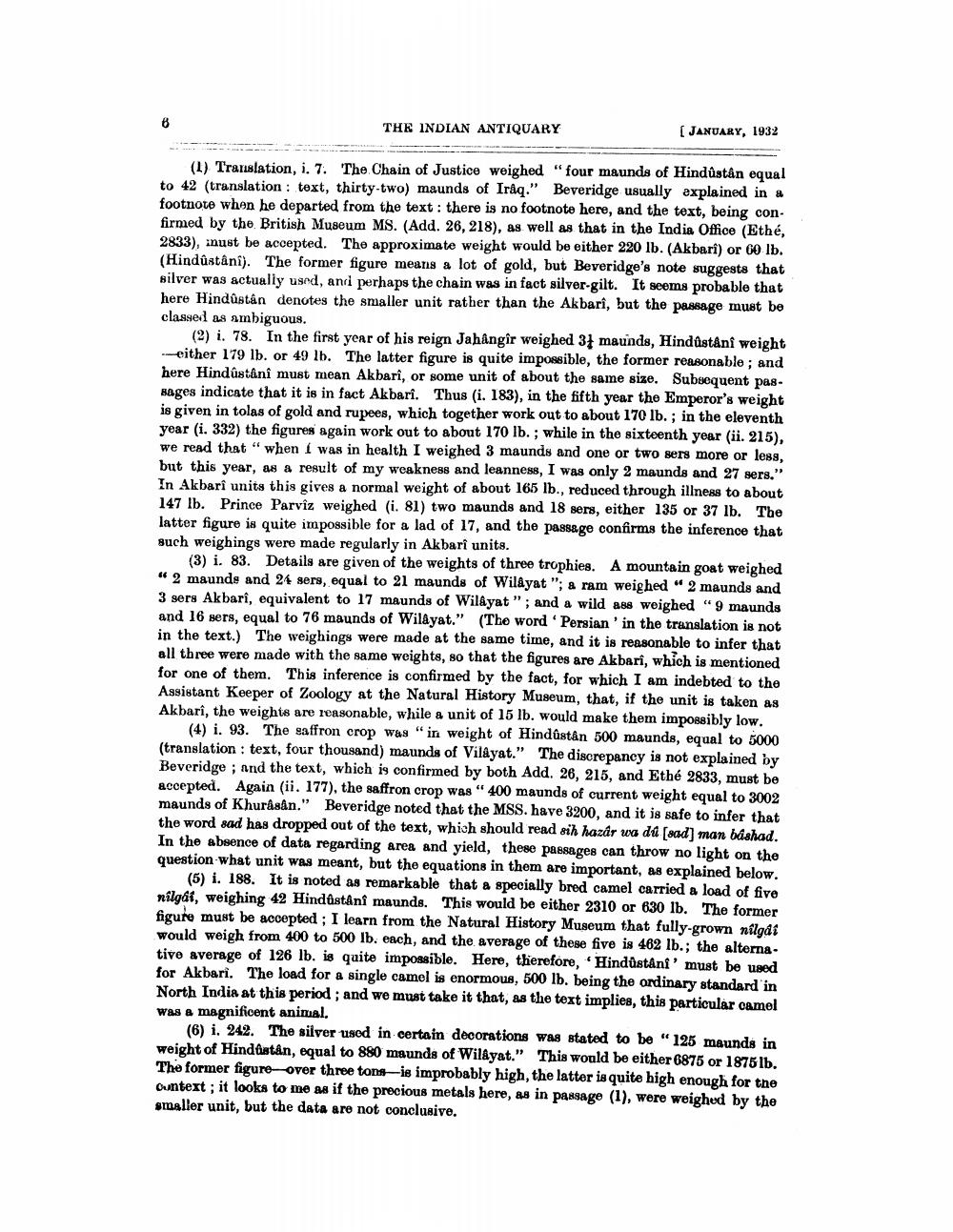________________
THE INDIAN ANTIQUARY
(JANUARY, 1932
(1) Translation, i. 7. The Chain of Justice weighed "four maunds of Hindustan equal to 42 (translation: text, thirty-two) maunds of Iraq." Beveridge usually explained in a footnote when he departed from the text : there is no footnote here, and the text, being con. firmed by the British Museum MS. (Add. 26, 218), as well as that in the India Office (Ethé, 2833), nust be accepted. The approximate weight would be either 220 lb. (Akbari) or 60 lb. (Hindústâni). The former figure means a lot of gold, but Beveridge's note suggests that silver was actually used, anri perhaps the chain was in fact silver-gilt. It seems probable that here Hindûstán denotes the smaller unit rather than the Akbarî, but the passage must be classed as ambiguous.
(2) i. 78. In the first year of his reign Jahângîr weighed 31 maunds, Hindústânî weight either 179 lb. or 49 lb. The latter figure is quite impossible, the former reasonable ; and here Hindústäni must mean Akbari, or some unit of about the same size. Subsequent pas. Bages indicate that it is in fact Akbari. Thus (i. 183), in the fifth year the Emperor's weight is given in tolas of gold and rupees, which together work out to about 170 lb. ; in the eleventh year (i. 332) the figures again work out to about 170 lb. ; while in the sixteenth year (ii. 215), we read that " when I was in health I weighed 3 maunds and one or two sers more or less, but this year, as a result of my weakness and leanness, I was only 2 maunds and 27 sers." In Akbari units this gives a normal weight of about 165 lb., reduced through illness to about 147 lb. Prince Parviz weighed (i. 81) two maunds and 18 sers, either 135 or 37 lb. The latter figure is quite impossible for a lad of 17, and the passage confirms the inference that such weighings were made regularly in Akbari units.
(3) i. 83. Details are given of the weights of three trophies. A mountain goat weighed " 2 maunds and 24 sers, equal to 21 maunds of Wilayat "; a ram weighed "2 maunds and 3 sers Akbari, equivalent to 17 maunds of Wilâyat"; and a wild ass weighed "9 maunds and 16 sers, equal to 76 maunds of Wilayat." (The word 'Persian' in the translation is not in the text.) The weighings were made at the same time, and it is reasonable to infer that all three were made with the same weights, so that the figures are Akbarî, which is mentioned for one of them. This inference is confirmed by the fact, for which I am indebted to the Assistant Keeper of Zoology at the Natural History Museum, that, if the unit is taken as Akbarî, the weights are reasonable, while a unit of 15 lb. would make them impossibly low.
(4) i. 93. The saffron crop was "in weight of Hindústân 500 maunds, equal to 5000 (translation : text, four thousand) maunds of Vilayat." The discrepancy is not explained by Beveridge ; and the text, which is confirmed by both Add. 26, 215, and Ethé 2833, must be accepted. Again (ii. 177), the saffron crop was " 400 maunds of current weight equal to 3002 maunds of Khurasan." Beveridge noted that the MSS. have 3200, and it is safe to infer that the word sad has dropped out of the text, which should read sih hazár wa dd (sad) man bäshad. In the absence of data regarding area and yield, these passages can throw no light on the question what unit was meant, but the equations in them are important, as explained below.
(5) i. 188. It is noted as remarkable that a specially bred camel carried a load of five nilgai, weighing 42 Hindôstânî maunds. This would be either 2310 or 630 lb. The former figure must be accepted : I learn from the Natural History Museum that fully-grown nilgdi would weigh from 400 to 500 lb. each, and the average of these five is 462 lb.; the alternative average of 126 lb. is quite impossible. Here, therefore, Hindustani' must be used for Akbari. The load for a single camel is enormous, 500 lb. being the ordinary standard in North India at this period; and we must take it that, as the text implies, this particular camel was a magnificent animal
(6) i. 242. The silver used in certain decorations was stated to be "125 maunds in weight of Hindustan, equal to 880 maunds of Wilayat." This would be either 6876 or 1875 lb. The former figure over three tons-is improbably high, the latter is quite high enough for the puntext; it looks to me as if the precious metals here, as in passage (1), were weighed by the smaller unit, but the data are not conclusive.




